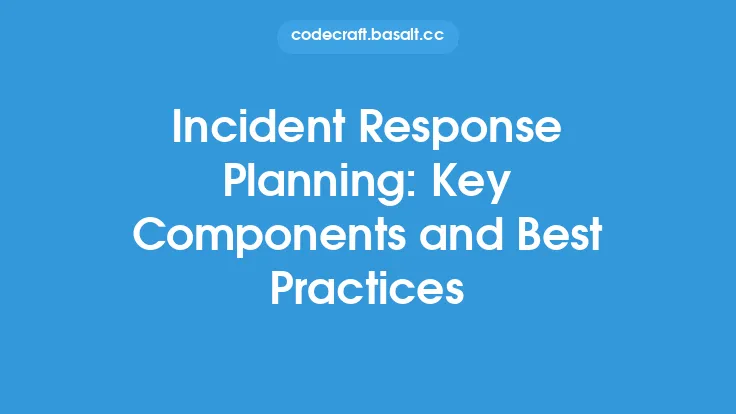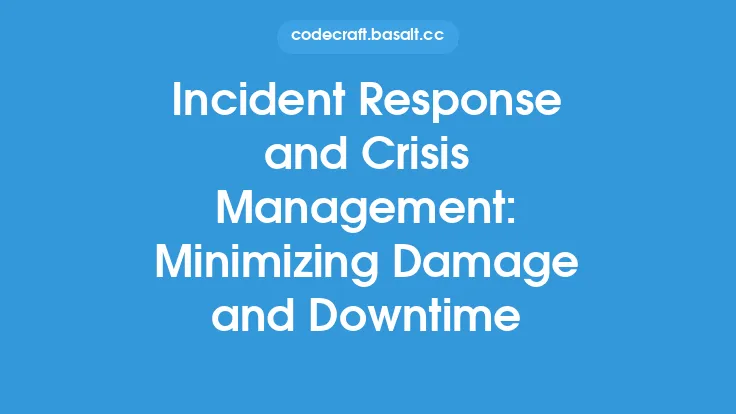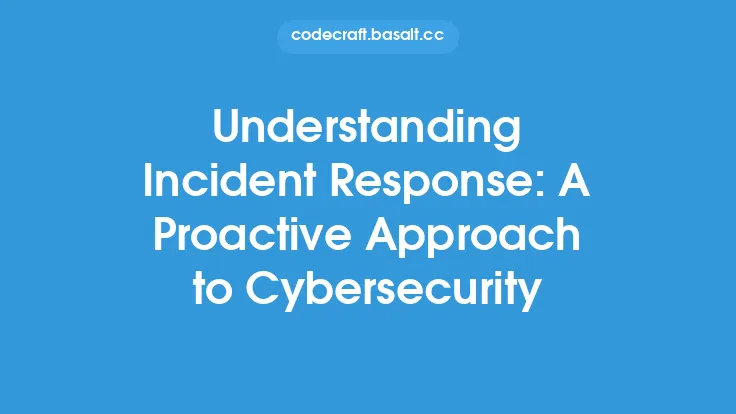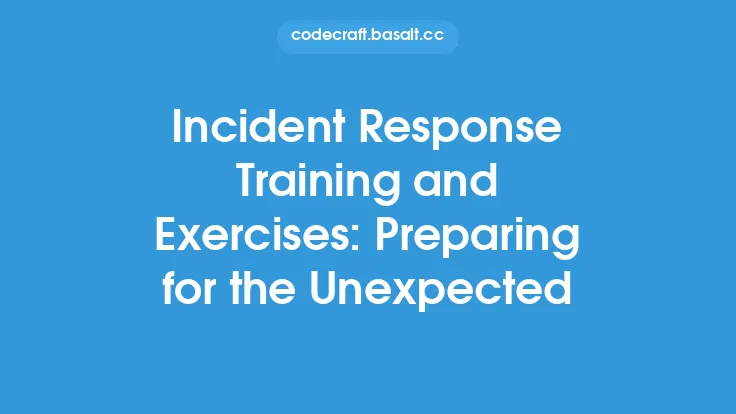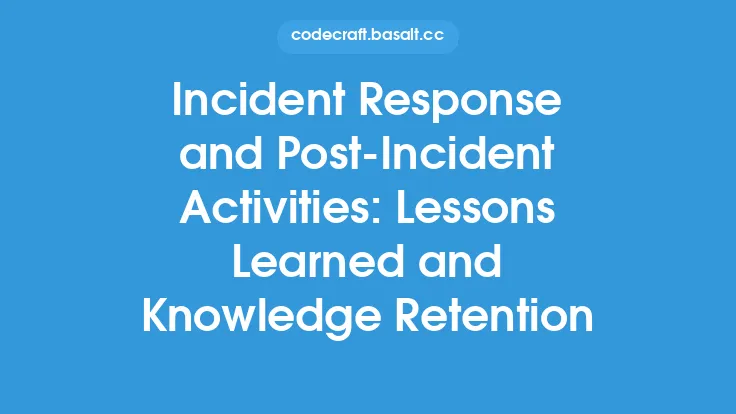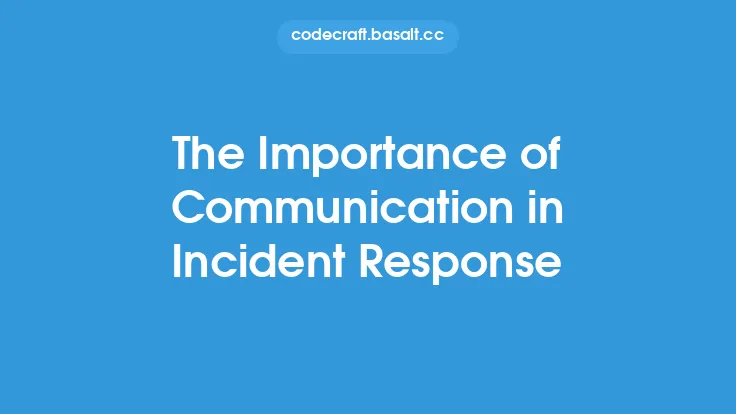Developing a well-structured and effective incident response team is crucial for any organization to respond promptly and efficiently to security incidents. The primary goal of an incident response team is to minimize the impact of a security breach, reduce downtime, and prevent future incidents. In this article, we will delve into the key aspects of building an effective incident response team, including the skills and expertise required, the importance of clear roles and responsibilities, and the need for ongoing training and improvement.
Incident Response Team Structure
An incident response team typically consists of a group of individuals with diverse skills and expertise, including technical, communication, and management skills. The team structure may vary depending on the organization's size, industry, and specific needs. However, a typical incident response team includes the following roles:
- Incident Response Manager: responsible for overseeing the incident response process, making strategic decisions, and ensuring that the team is adequately equipped and trained.
- Security Analysts: responsible for monitoring and analyzing security event logs, identifying potential security threats, and providing technical expertise during incident response.
- Communications Specialist: responsible for coordinating internal and external communications, including incident notifications, updates, and press releases.
- Technical Experts: responsible for providing specialized technical expertise, such as network, system, or application knowledge, to support incident response efforts.
- Management Liaison: responsible for coordinating with senior management, ensuring that incident response efforts are aligned with organizational goals and objectives.
Skills and Expertise
Incident response team members require a range of skills and expertise to effectively respond to security incidents. Some of the key skills and expertise include:
- Technical skills: proficiency in operating systems, network protocols, and security technologies, such as firewalls, intrusion detection systems, and encryption.
- Analytical skills: ability to analyze complex security event logs, identify patterns, and draw conclusions.
- Communication skills: ability to effectively communicate technical information to non-technical stakeholders, including management, customers, and the media.
- Problem-solving skills: ability to think critically and develop creative solutions to complex security problems.
- Collaboration skills: ability to work effectively in a team environment, share information, and coordinate efforts.
Clear Roles and Responsibilities
Clear roles and responsibilities are essential for an effective incident response team. Each team member should have a well-defined role, with specific responsibilities and expectations. This includes:
- Incident classification and prioritization: team members should be able to quickly classify and prioritize incidents based on severity and impact.
- Incident response procedures: team members should be familiar with established incident response procedures, including containment, eradication, recovery, and post-incident activities.
- Communication protocols: team members should be aware of communication protocols, including incident notification, updates, and reporting requirements.
- Escalation procedures: team members should know when to escalate incidents to senior management or external authorities.
Ongoing Training and Improvement
Incident response teams require ongoing training and improvement to stay up-to-date with the latest security threats, technologies, and best practices. This includes:
- Regular training sessions: team members should participate in regular training sessions, including workshops, conferences, and online courses.
- Tabletop exercises: team members should participate in tabletop exercises, which simulate real-world security incidents, to test incident response procedures and identify areas for improvement.
- Post-incident reviews: team members should conduct post-incident reviews, which involve analyzing incident response efforts, identifying lessons learned, and implementing improvements.
- Continuous monitoring: team members should continuously monitor security event logs, threat intelligence feeds, and other sources of security information to stay informed about potential security threats.
Incident Response Team Operations
Incident response team operations involve a range of activities, including incident detection, classification, and prioritization, as well as containment, eradication, recovery, and post-incident activities. The following are some key aspects of incident response team operations:
- Incident detection: team members should be able to quickly detect security incidents, using a range of tools and techniques, including security event log monitoring, network traffic analysis, and threat intelligence feeds.
- Incident classification and prioritization: team members should be able to quickly classify and prioritize incidents based on severity and impact, using established incident classification and prioritization procedures.
- Containment: team members should be able to quickly contain security incidents, using a range of techniques, including network segmentation, system isolation, and application of security patches.
- Eradication: team members should be able to eradicate security incidents, using a range of techniques, including malware removal, system restoration, and application of security updates.
- Recovery: team members should be able to recover from security incidents, using a range of techniques, including system restoration, data recovery, and application of security updates.
- Post-incident activities: team members should conduct post-incident reviews, which involve analyzing incident response efforts, identifying lessons learned, and implementing improvements.
Tools and Technologies
Incident response teams require a range of tools and technologies to support incident response efforts, including:
- Security event log monitoring tools: tools that monitor security event logs, such as Splunk, ELK, or LogRhythm.
- Network traffic analysis tools: tools that analyze network traffic, such as Wireshark, Tcpdump, or NetworkMiner.
- Threat intelligence feeds: feeds that provide real-time threat intelligence, such as FireEye, Symantec, or McAfee.
- Incident response platforms: platforms that provide incident response capabilities, such as ServiceNow, JIRA, or IBM Resilient.
- Collaboration tools: tools that facilitate collaboration and communication, such as Slack, Microsoft Teams, or email.
Best Practices
The following are some best practices for developing an effective incident response team:
- Establish clear roles and responsibilities: ensure that each team member has a well-defined role, with specific responsibilities and expectations.
- Develop incident response procedures: establish procedures for incident classification, prioritization, containment, eradication, recovery, and post-incident activities.
- Provide ongoing training and improvement: provide regular training sessions, tabletop exercises, and post-incident reviews to ensure that team members stay up-to-date with the latest security threats, technologies, and best practices.
- Continuously monitor security event logs: continuously monitor security event logs, threat intelligence feeds, and other sources of security information to stay informed about potential security threats.
- Conduct regular tabletop exercises: conduct regular tabletop exercises to test incident response procedures and identify areas for improvement.
